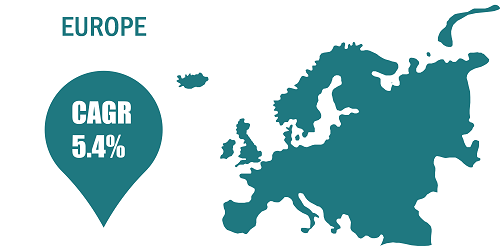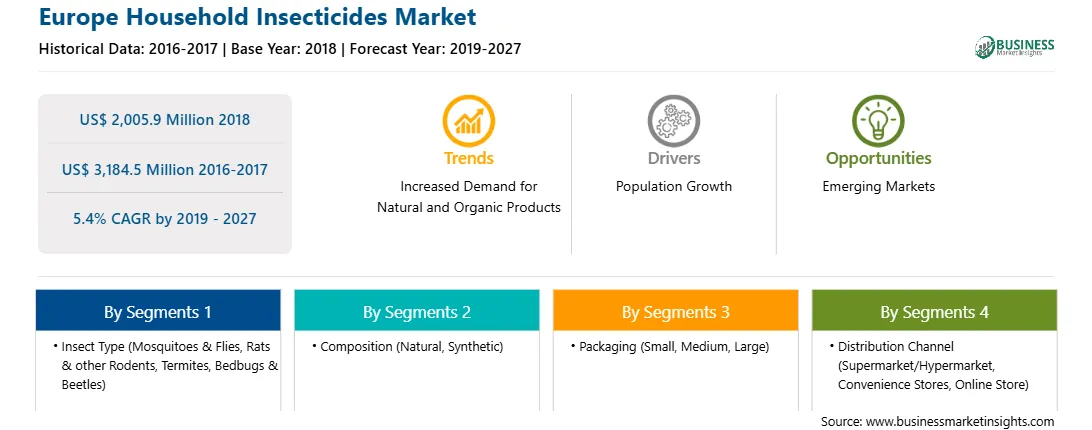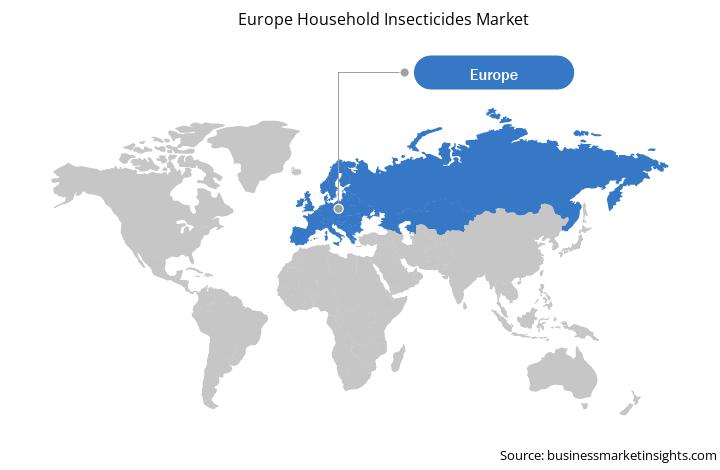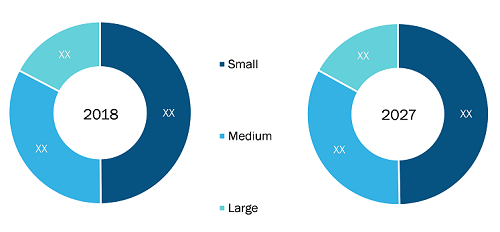In 2018, Italy dominated the Europe household insecticides market, followed by France. The market for household insecticides in Italy is increasing as government and local authorities in Italy have taken up initiatives encouraging the use of household insecticides for protection against vector borne diseases. The importation of mosquito species such as Ae. Albopictus in Italy has resulted in the spread of vector borne diseases in the country. Ae. Albopictus has now spread in 22 provinces, in the north east part of the Italy. Italy is now considered the most heavily-infested country in Europe, with the highest incidence of mosquitos in the Veneto and Friuli-Venezia-Giulia regions, large swathes of Lombardia and Emilia-Romagna and coastal areas of central Italy. The growing mosquito menace in Italy has propelled the demand for mosquito insecticides and other pesticides. The growing use of insecticides to mitigate the epidemics caused by mosquitos is expected to drive the household insecticide market in Italy during the forecast period.

Strategic insights for the Europe Household Insecticides provides data-driven analysis of the industry landscape, including current trends, key players, and regional nuances. These insights offer actionable recommendations, enabling readers to differentiate themselves from competitors by identifying untapped segments or developing unique value propositions. Leveraging data analytics, these insights help industry players anticipate the market shifts, whether investors, manufacturers, or other stakeholders. A future-oriented perspective is essential, helping stakeholders anticipate market shifts and position themselves for long-term success in this dynamic region. Ultimately, effective strategic insights empower readers to make informed decisions that drive profitability and achieve their business objectives within the market.

| Report Attribute | Details |
|---|---|
| Market size in 2018 | US$ 2,005.9 Million |
| Market Size by 2027 | US$ 3,184.5 Million |
| Global CAGR (2019 - 2027) | 5.4% |
| Historical Data | 2016-2017 |
| Forecast period | 2019-2027 |
| Segments Covered |
By Insect Type
|
| Regions and Countries Covered | Europe
|
| Market leaders and key company profiles |
The geographic scope of the Europe Household Insecticides refers to the specific areas in which a business operates and competes. Understanding local distinctions, such as diverse consumer preferences (e.g., demand for specific plug types or battery backup durations), varying economic conditions, and regulatory environments, is crucial for tailoring strategies to specific markets. Businesses can expand their reach by identifying underserved areas or adapting their offerings to meet local demands. A clear market focus allows for more effective resource allocation, targeted marketing campaigns, and better positioning against local competitors, ultimately driving growth in those targeted areas.

Mosquito-borne diseases are cited among the world's leading causes of death and illness. The World Health Organization predicts that more than 300 million clinical cases are attributable to mosquito-borne diseases each year. Despite great strides over the last five decades, mosquito-borne illnesses continue to posture significant risks to a significant share of the population in Southern Europe. Current challenges postured by the emergence of West Nile virus in the Western hemisphere demonstrates the importance of cooperation and partnership of government to enhance public health. The World Health Organization (WHO) and the European Centre for Disease Prevention and Control (ECDC) are closely working with each other with the assistance of other federal, state, and local agencies to further protect the public from mosquito-borne diseases such as the West Nile virus. European Mosquito Control Association (EMCA) has collaborated with ECDC (European Centre for Disease Prevention and Control), and E-SOVE (European Society for Vector Ecology), for dealing with the control of vectors that cause vector borne diseases to humans. It promotes public and governmental awareness campaigns relating to mosquito control and associated subjects.
Based on insect types, the Europe household insecticides market is bifurcated as mosquitoes & flies, rats & other rodents, termites, bedbugs & beetles, and others. There has been a rising demand for mosquito insecticides in the Europe market. Malathion and permethrin are the two leading household insecticides which are effective against mosquitoes. The flies have been noted to be responsible for many contagious diseases and the insecticides have been observed to be beneficial for the elimination of these flies. The houseflies are known to rest on sunny surfaces during the day and are known to enter the house during the evenings. The areas where these flies come and rest need to be sprayed with insecticides. One of the most significantly used ingredients in the flies' insecticide is pyrethrin. Pyrethrins are used in the aerosol form that works quickly and do not give lasting residues.
There has been a rising demand for the household insecticides due to the growing awareness of the effects of the insects on the human health. On the basis of composition, the Europe household insecticides market is bifurcated as natural and synthetic. The synthetic segment dominated the Europe household insecticides market whereas natural segment is expected to grow at fastest growth rate during the forecast period of 2019-2027. The rising awareness of the effects of insects and it playing the role of epidemic diseases has led to an upsurge in the use of household insecticides and synthetic household insecticides in particular. Synthetic household insecticides are widely used all over Europe as they are relatively inexpensive and are very efficient in killing pest and insects. The rising spread of mosquitoes, and other bugs due to deforestation and rapid urbanization is expected to drive the market for synthetic household insecticides market in the forecast period. To mitigate the dwindling bees population governments are imposing ban on synthetic insecticides and promoting natural insecticides.
The Europe household insecticides market is bifurcated based on packaging into small, medium, and large. The small segment leads the Europe household insecticides market whereas medium segment is expected to grow at fastest growth rate during the forecast period of 2019-2027. The small packaging type of household insecticides generally weighs between 250 gm. to 500 gm. It has been noted that the small packaging insecticides have been frequently used as they are easy to port and can be used before the product expires. It has a short period of use due to its acute weight. The easy portability and low weight of the small packaging household insecticides has been a contributing factor for the expansion of the household insecticides market all over Europe.

Strategic insights for the Europe Household Insecticides provides data-driven analysis of the industry landscape, including current trends, key players, and regional nuances. These insights offer actionable recommendations, enabling readers to differentiate themselves from competitors by identifying untapped segments or developing unique value propositions. Leveraging data analytics, these insights help industry players anticipate the market shifts, whether investors, manufacturers, or other stakeholders. A future-oriented perspective is essential, helping stakeholders anticipate market shifts and position themselves for long-term success in this dynamic region. Ultimately, effective strategic insights empower readers to make informed decisions that drive profitability and achieve their business objectives within the market.

| Report Attribute | Details |
|---|---|
| Market size in 2018 | US$ 2,005.9 Million |
| Market Size by 2027 | US$ 3,184.5 Million |
| Global CAGR (2019 - 2027) | 5.4% |
| Historical Data | 2016-2017 |
| Forecast period | 2019-2027 |
| Segments Covered |
By Insect Type
|
| Regions and Countries Covered | Europe
|
| Market leaders and key company profiles |
The geographic scope of the Europe Household Insecticides refers to the specific areas in which a business operates and competes. Understanding local distinctions, such as diverse consumer preferences (e.g., demand for specific plug types or battery backup durations), varying economic conditions, and regulatory environments, is crucial for tailoring strategies to specific markets. Businesses can expand their reach by identifying underserved areas or adapting their offerings to meet local demands. A clear market focus allows for more effective resource allocation, targeted marketing campaigns, and better positioning against local competitors, ultimately driving growth in those targeted areas.

New product development, market initiatives and merger and acquisition were observed as the most adopted strategies in Europe household insecticides market. Few of the recent developments in the Europe Household insecticides market are listed below:
The List of Companies
The Europe Household Insecticides Market is valued at US$ 2,005.9 Million in 2018, it is projected to reach US$ 3,184.5 Million by 2027.
As per our report Europe Household Insecticides Market, the market size is valued at US$ 2,005.9 Million in 2018, projecting it to reach US$ 3,184.5 Million by 2027. This translates to a CAGR of approximately 5.4% during the forecast period.
The Europe Household Insecticides Market report typically cover these key segments-
The historic period, base year, and forecast period can vary slightly depending on the specific market research report. However, for the Europe Household Insecticides Market report:
The Europe Household Insecticides Market is populated by several key players, each contributing to its growth and innovation. Some of the major players include:
The Europe Household Insecticides Market report is valuable for diverse stakeholders, including:
Essentially, anyone involved in or considering involvement in the Europe Household Insecticides Market value chain can benefit from the information contained in a comprehensive market report.